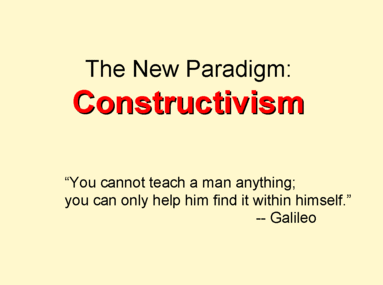Constructivism
“Constructivism is a philosophy of learning founded on the premise that by reflecting on our experiences, we construct our own understanding of the world we live in. Each of us generates our own “rules” and “mental models,” which we use to make sense of our experiences. Learning, therefore, is simply the process of adjusting our mental models to accommodate new experiences” (http://www.funderstanding.com/content/constructivis). Although not a new theory, it will take on increased importance in the 2020 classroom.
 Constructivists believe that based on prior experiences and knowledge, meaningful learning takes place when individuals construct their own meaning, rather than memorize answers and regurgitate what they’ve been taught. Therefore, inherent in a constructivist curriculum is the rejection of a one-size-fits-all approach to learning and instead the belief that education needs to personalized. As per Jonassen Peck and Wilson (1999) Constructivist learning emphasizes five different attributes of meaningful learning:
Constructivists believe that based on prior experiences and knowledge, meaningful learning takes place when individuals construct their own meaning, rather than memorize answers and regurgitate what they’ve been taught. Therefore, inherent in a constructivist curriculum is the rejection of a one-size-fits-all approach to learning and instead the belief that education needs to personalized. As per Jonassen Peck and Wilson (1999) Constructivist learning emphasizes five different attributes of meaningful learning:
- Intentional learning
- Active learning
- Constructive learning
- Cooperative learning
- Authentic Learning
Another way to describe this Constructivist philosophy has been captured in the Biological Science Curriculum Study (BSCS). In this model the approach is summarized through five "E"'s: Engage, Explore, Explain, Elaborate and Evaluate. The 5 E's have also been expanded/adapted into the 7 E's which are defined as: Excite, Explore, Explain, Expand, Extend, Exchange and Examine (The pH Factor: Constructivism and the 5 E's)
The ideology though is clear: by focusing on overarching concepts rather than isolated facts, constructivists nurture critical thinking skills. Students are encouraged to connect ideas by summarizing concepts; analyzing, interpreting, and predicting information; as well as justifying and defending their ideas. As constructivist philosophy also purports that learning is an active social process, collaboration among learners and teachers is a mainstay in a constructivist classroom, and is interactive, dynamic and experienced based with teachers promoting extensive dialogue among students.
 The role of the teacher is significantly altered in a constructivist classroom when compared with that of a more traditional classroom as well. In the constructivist classroom the teacher, rather than functioning as the gatekeeper to all information and that which is correct, acts as a facilitator whose job it is to enable students to come to their own understanding. The focus is removed from the teacher and her lecture and puts it upon the students and their learning. This idea is summarized by the popular saying that the constructivist teacher is "the guide on the side rather than the sage on the stage"
The role of the teacher is significantly altered in a constructivist classroom when compared with that of a more traditional classroom as well. In the constructivist classroom the teacher, rather than functioning as the gatekeeper to all information and that which is correct, acts as a facilitator whose job it is to enable students to come to their own understanding. The focus is removed from the teacher and her lecture and puts it upon the students and their learning. This idea is summarized by the popular saying that the constructivist teacher is "the guide on the side rather than the sage on the stage"
Online learning enables and supports the learner-centric Constructivist teaching philosophy. Internet based activities facilitate exploration and knowledge building by students. Collaboration is supported through a multitude of social networking and virtual meeting room sites. Students have access to limitless sources of authentic, current information in their content areas of interest while also having the opportunity to become active producers of information through access to a vast array of free and open source presentation and multimedia tools.
Sample Virtual Meeting Tools
Sample Presentation Tools
- animoto.com,
- authorstream
- glogster.com/edu,
- jing
- moviestorm
- prezi.com,
- photostory
- scratch
- voicethread.com,
- vuvox.com
- xtranormal.com
Resources:
Constructivism (http://www.funderstanding.com/content/constructivism)
Constructivism Learning Theory http://www.teach-nology.com/currenttrends/constructivism/
Constructivism and 5 E's http://www.miamisci.org/ph/lpintro5e.html
Jonassen, D., Peck, K., & Wilson, B. (1999). Learning with technology: A constructivist perspective. (, Ed.) (p. 0). Prentice Hall.
Next up, see Connectivism
